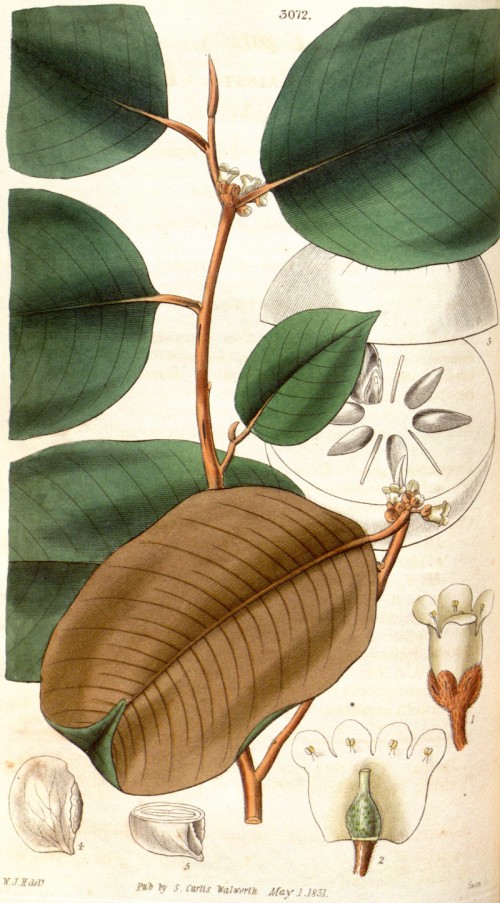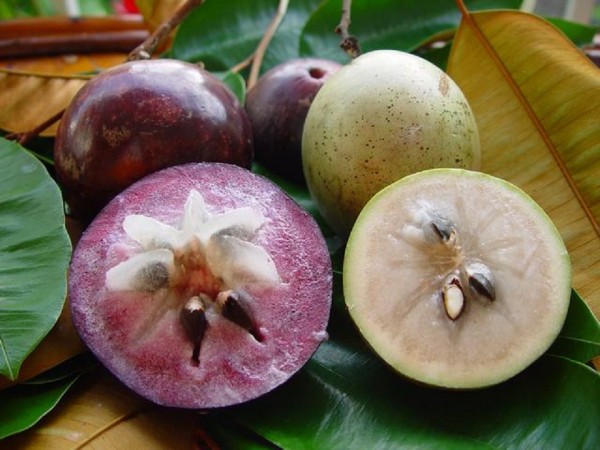Dies ist eine alte Version des Dokuments!
Chrysophyllum cainito L. - Sapotaceae - star apple, caimito tree, caimito (span.), Sternapfel
Evergreen tree, up to 20m high, native to the Caribbean, naturalized and cultivated in Central America and Southeast Asia; leaves alternate, oblong-elliptic to oblanceolate-elliptic, entire, upper side glabrous, abaxially golden-brown; flowers tiny, purplish white, sweet fragrant; fruit globose, usually purple to black (or red, brown, greenish-yellow). The edible fruit pulp is white, soft, and milky.
„The fruits are delicious as a fresh dessert fruit; it is sweet and best served chilled. Infusions of the leaves have been used against diabetes and articular rheumatism. The fruit has anti-oxidant properties. The bark is considered a tonic and stimulant, and a bark decoction is used as an antitussive.“
http://en.wikipedia.org/wiki/Chrysophyllum_cainito
One hundred and four compounds were identified in the aroma concentrate from C. cainito fruits growing in Cuba, „… of which (E)-2-hexenal, 1-hexanol, limonene, linalool, α-copaene and hexadecanoic acid were found to be the major constituents. The presence of many terpenic compounds is thought to contribute to the unique flavour of the star apple fruit.“
[Volatile constituents of star apple (Chrysophyllum cainito L.) from Cuba., Pino, J., Marbot, R., Rosado, A., Flavour and fragrance journal, Vol.17(5), 2002, 401-403]
The fruits contain polyphenolic antioxidants, mainly (−)-epicatechin, but also (+)-catechin, (+)-gallocatechin, (−)-epigallocatechin, quercetin, quercitrin, isoquercitrin, myricitrin, and gallic acid.
[Polyphenolic antioxidants from the fruits of Chrysophyllum cainito L.(star apple)., Luo, X.D., Basile, M.J., Kennelly, E.J., Journal of agricultural and food chemistry, Vol.50(6), 2002, 1379-1382]
Main sugars (330mg/g d.w.) of ripe fruits from Thailand were maltose (113mg/g), glucose (99mg/g), and fructose (117mg/g).
[Phytochemicals, vitamin C and sugar content of Thai wild fruits., Kubola, J., Siriamornpun, S., Meeso, N., Food Chemistry, Vol.126(3), 2011, 972-981]
http://www.thaiscience.info/Article%20for%20ThaiScience/Article/1/Ts-1%20phytochemicals,%20vitamin%20c%20and%20sugar%20content%20of%20thai%20wild%20fruits.pdf

Curtis’s Botanical Magazine, vol. 58 [ser. 2, vol. 5]: t. 3072 (1831) [W.J. Hooker]
http://plantgenera.org/species.php?id_species=240774
 picture source Zoom's Edible Plants
picture source Zoom's Edible Plants
